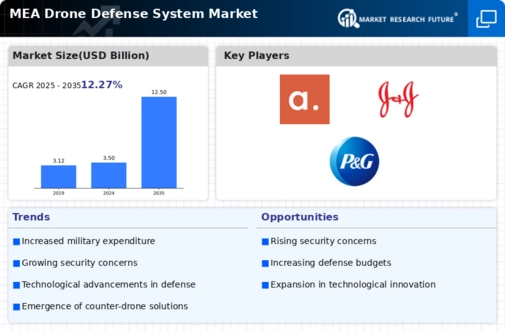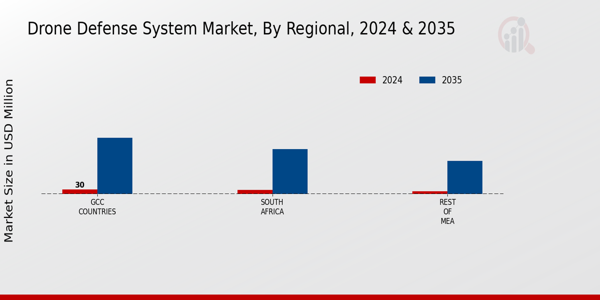Market Growth Projections
The Global MEA Drone Defense System Market Industry is poised for substantial growth, with projections indicating a market size of 3.5 USD Billion in 2024 and an anticipated increase to 12.5 USD Billion by 2035. This growth trajectory suggests a compound annual growth rate (CAGR) of 12.27% from 2025 to 2035. Such figures reflect the increasing recognition of the importance of drone defense systems in ensuring national security and protecting critical infrastructure. As nations invest in advanced technologies and respond to emerging threats, the market is expected to expand significantly, highlighting the critical role of drone defense systems in the region.
Technological Advancements
Rapid technological advancements in drone detection and neutralization systems are significantly influencing the Global MEA Drone Defense System Market Industry. Innovations such as artificial intelligence and machine learning are enhancing the capabilities of defense systems, allowing for more precise identification and interception of threats. Countries like Israel are at the forefront of developing cutting-edge drone defense solutions, which are being adopted by various nations in the MEA region. As these technologies evolve, they are expected to drive market growth, with projections indicating a rise to 12.5 USD Billion by 2035. This suggests a strong trajectory for the adoption of sophisticated defense systems.
Rising Military Expenditure
The rise in military expenditure across the Middle East and Africa is a significant factor propelling the Global MEA Drone Defense System Market Industry. Countries are increasingly allocating larger portions of their budgets to enhance their military capabilities, including aerial defense systems. For instance, nations such as Egypt and Qatar are expanding their defense budgets to incorporate advanced drone defense technologies. This trend not only reflects the growing recognition of aerial threats but also indicates a commitment to maintaining national security. As military spending continues to rise, the demand for drone defense systems is expected to increase, further driving market growth.
Increasing Security Concerns
The Global MEA Drone Defense System Market Industry is driven by escalating security concerns across the Middle East and Africa. Nations in this region face threats from unauthorized drone activities, which have heightened the demand for effective defense systems. For instance, countries like Saudi Arabia and the UAE are investing heavily in drone defense technologies to protect critical infrastructure and military assets. The market is projected to reach 3.5 USD Billion in 2024, reflecting a growing recognition of the need for robust aerial defense mechanisms. This trend indicates that governments are prioritizing investments in advanced technologies to counter potential aerial threats.
Government Initiatives and Investments
Government initiatives and investments in defense capabilities are pivotal drivers of the Global MEA Drone Defense System Market Industry. Many governments in the region are recognizing the strategic importance of drone defense and are allocating substantial budgets for research and development. For example, the UAE has launched several initiatives aimed at enhancing its defense infrastructure, including drone defense systems. This proactive approach is likely to create a favorable environment for market growth, as increased funding leads to the development and deployment of advanced technologies. The anticipated CAGR of 12.27% from 2025 to 2035 underscores the potential for sustained investment in this sector.
Emerging Threats and Geopolitical Tensions
Emerging threats and geopolitical tensions in the MEA region are crucial drivers of the Global MEA Drone Defense System Market Industry. The proliferation of drones among non-state actors and the potential for their use in asymmetric warfare have prompted nations to bolster their aerial defense capabilities. Countries like Iran and Turkey are actively developing drone technologies, which raises concerns among neighboring nations. This dynamic environment necessitates the implementation of effective drone defense systems to safeguard national interests. As a result, the market is likely to experience significant growth as countries respond to these evolving threats.















Leave a Comment